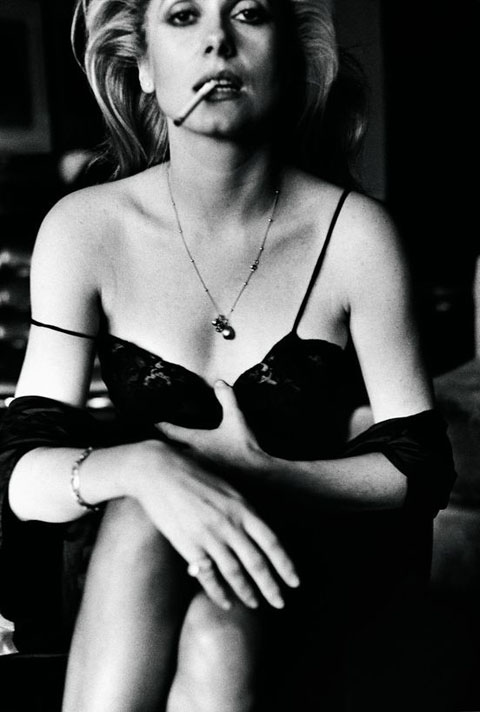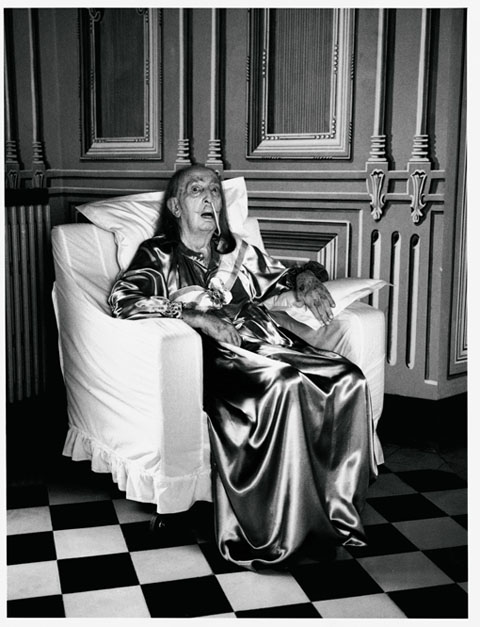|

Photography copyright © Helmut Newton; poster copyright © Affiche Reunion
Rue Aubriot, Paris, 1975, for Vogue Paris

Sie Kommen, Paris, 1981

Catherine Deneuve, 1976

Salvador Dali, Figueras, Spain, 1986, published in Vanity Fair
There are those who are photogenic and others whose blaze of beauty sparks better, away from a camera’s flashing light.
The truly talented photographer has a skill of making anything and anyone look intriguing.
The famous Helmut Neustädter (later known as Newton), once
said, ‘Any photographer who says he is not a voyeur is either stupid
or a liar’—outlining the humorous approach that he had taken.
France might have recently been busy for the elections but the French
capital was undoubtedly in for a treat on March 24 when they welcomed
the ‘voyeur’s’ works of art to be viewed for a limited time, until
June 17. The southeast gallery located in the Grand Palais through
the Winston Churchill Avenue entrance captured fashionably artistic features that were once only seen through
the eyes of the legendary photographer. The exhibition invites visitors
to step into Newton’s universe behind the majestic
Grand Palais doors. June, Newton’s wife of sixty years, was a curator
of the exhibition along with Jérôme Neutres.
‘My job as a portrait photographer is to seduce, amuse and entertain,’
said Newton once. Through his work, he allows onlookers to discover stunning
and natural beauty. ‘Nothing has been retouched, nothing electronically
altered, I photographed what I saw.’ He took pictures of the men of
fashion, the fashionable women who revealed extreme power and supremacy, and simple figures that he was
able to transform into pieces of absolute sophistication.
The German–Australian photographer was born in Berlin on October
31, 1920. It was in 1932 that the young Newton would buy his first
camera, propelling him toward his successful
career of high-end photography. Much of the famous photographer’s
work was taken in France. He also shot for a wide
range of importantly famed fashion magazines, including Marie-Claire,
Elle and Vogue.
As visitors walk through the exhibition’s large space, they notice
surrounding walls closely embraced by his artistic works of art.
By admiring the images which contain seductive, simple and classy
looks, with both femininity and sexuality disclosed, spectators begin
to understand to what extent his work would be considered exceptional.
Although we call his work ‘art’, that may as well be an inappropriate
word to use since Newton himself considered it to be an understatement.
‘Some people’s photography is an art. Not mine. Art is a dirty word
in photography. All this dirty art crap is killing it already.’
continued below

Photography copyright © Helmut Newton; poster copyright © Affiche Reunion
Rue Aubriot, Paris, 1975, for Vogue Paris
Newton died in 2004, leaving behind a collection of classic photographs
for people to enjoy and admire. Since the talented artist’s death,
this is the first retrospective in France, leaving visitors
yearning for more as they exit and continue to ponder upon his everlasting
work.
There are more than 200 photos on display. A number
included images of famous faces from Catherine Deneuve, Yves Saint
Laurent, Pierre Cardin, Andy Warhol, Margaret Thatcher, HSH Princess
Caroline of Monaco, HSH Prince Albert of Monaco and Elizabeth Taylor.
It comes as no coincidence that Newton chose powerfully influential
female celebrities to strike a pose for him; the idea of feminine
strength is an attribute that persists throughout his
work.
Newton has the capacity to take even an elegant Walter Steiger
shoe on a woman’s foot and alter it into a stylishly chic look through
his fine photography. He had an eye for fashion and he was able
to share such an imagination with the world through his stills.
Many images rouse a flare of wit and a gleam of highly fashionable
elements. One of the many photographs that caught the eye was of a huge
portrait of four women entitled Sie Kommen (They’re Coming). The
women are elegantly dressed in attractive garments revealing their
expensive taste and their powerful gestures; once the viewer turns
their head slightly to the right they find the same women in the
same poses but in the nude with only their
high heels and chic hairdos to show off. The two extremes expose
feminine appeal and authority. Images of models in the nude recur, confirming the model’s utter confidence and the photographer’s
wild imagination.
Seduction and flirtatiousness are visible
through each angle. In the late 1960s, Yves Saint
Laurent was considered a designer who empowered women by providing
them with ensembles and outfits that were normally worn by the opposite
sex—it was his approach to liberate women. It was Newton’s intention
to do the same by presenting the ‘Newtonian woman’.
In the middle of the spacious venue is a small and dark room reserved
for a few people to watch a brief documentary of the photographer
busy at work. Newton actively tells models how to stand and where
to look, as though it has all been previously planned out: ‘… If
she’s smart she can understand immediately.’
Newton’s talent is highlighted throughout the exhibition with both
black-and-white as well as colour images that reveal female and
male models showing off forceful character, charm, charisma, class
and, of course, a flawless, fashionable appeal. The photographs
evoke a thousand words as they spectacularly come face to face with
observers. •

© Helmut Newton Estate
In Elle, 1968

In Paris, 1978, for Vogue Paris |
 |
By admiring the images which contain seductive, simple and classy looks with both femininity and sexuality disclosed, spectators begin to understand to what extent his work would be considered exceptional
Lola Saab is Paris editor of Lucire.
| Related articles |
 | Turn on, tune in, tone down
Though the pre-Emmy Awards social whirl was in full swing, Elyse Glickman finds practical, innovative items and socially relevant charities getting
the best critical response among A-listers in attendance |
 |
Getting your daily
dose
As Elyse Glickman and Leyla Messian transition into
summer, a host of wellness-themed events provide tips and tricks on
looking and feeling your best |
 |
Pop art
Los Angeles’ spring 2011 celebrity social season is a jumpy,
textured canvas of ’80s nostalgia, budget-friendly fashion finds,
common sense, practicality and just-because kitsch, report Elyse
Glickman and Leyla Messian |
|

